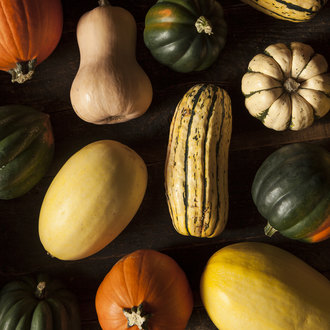Squash for Any Season
The two main types of squash are summer and winter squash. The difference between the two types is that summer squash has tender, light-coloured flesh with softer skins and are harvested at the immature stage. Varieties of summer squash include the zucchini, patty pan, yellow crookneck and yellow straight neck. Winter squash tends to have firmer flesh and seeds, with a hard shell and are harvested at the mature stage. Varieties of winter squash include butternut, acorn, delicata, spaghetti and sweet dumpling.
NUTRITION INFORMATION
Squash is a low-calorie food and has a high water content, being approximately 95% water. It is a great source of carbohydrates and fiber. Summer squash contains folate, potassium, vitamin C and phytonutrients lutein and zeaxanthin. Winter squash is also a source of potassium, niacin, iron and beta-carotene (the deeper the orange colour the higher the beta carotene content).
Nutrient Facts (1 cup cooked winter squash, cubes)
- Calories: 80
- Protein: 2 g
- Carbohydrate: 18 g
- Dietary Fiber: 6 g
- Calcium: 29 mg
- Iron: 0.7 mg
- Potassium: 896 mg
- Folate: 57 mcg
SELECTION
When choosing summer squash look for the smaller ones (~7 inches for long or less than 4 inches across for the patty pan). For both types of squash, the skins should be dry, glossy and without dents, decay or bruises. Avoid squash that is shriveled and dried out.
STORAGE
Summer squash can be stored in a plastic bag in the refrigerator crisper and will keep for about a week. Winter squash can be stored for several weeks in a cool dry place with good air circulation. Butternut and Hubbard varieties are fantastic for longer term storage.
PREPARATION
Summer Squash
Before cooking, wash and trim the vegetable. Summer squash usually does not have to be peeled and seeded unless it is older and tougher. The high water content of this vegetable means that cooked dishes may have a lot of liquid after cooking. To eliminate water before cooking, try blanching the whole vegetable for 2-8 minutes or until tender. Chill in ice and then cut into the appropriate size for the recipe. Alternatively, grate the zucchini and let sit on paper towel to remove excess water before adding to muffin or pancake batter. Summer squash can be baked, boiled, microwaved, sautéed, steamed or stir-fried. Add summer squash to stir fries, roasted vegetables, lasagna, spaghetti sauce, muffins and cakes. Zucchini spiralized is a low carbohydrate alternative to pasta.
Winter Squash
Winter squash can be more of a challenge to get at the tasty flesh. Thin-skinned varieties such as the butternut, acorn and delicata can be peeled with a paring knife or vegetable peeler. The seeds and strings can be scooped out with a spoon. Once the vegetable is peeled and seeded, it can be cut into cubes and roasted with spices or boiled in water or a stew. The seeds can be roasted separately on a cookie sheet with a pinch of salt or spices (eg. cumin, chili, taco, or curry) and vegetable oil for a delicious snack. Unpeeled winter squash can be cooked by slicing it in half, piercing the skin and placing it in the oven on a baking dish in a 350 F oven for ~ 30 minutes. Pierce with a fork or skewer to see if it is done. Once tender, the flesh can be removed from the shell and mashed with a fork or food processor. Squash pieces can also be microwaved on high for 15 minutes. Winter squash is fantastic in pies (adding cinnamon, nutmeg and cloves), stews, curry, soups, muffins and cakes. It can also be stuffed with spices, ground meats, legumes and other vegetables.
The Bottom Line: Squash is a delicious, versatile vegetable packed full of nutrients and can be enjoyed during any season.
Click for our recipe for Butternut Squash Soup















